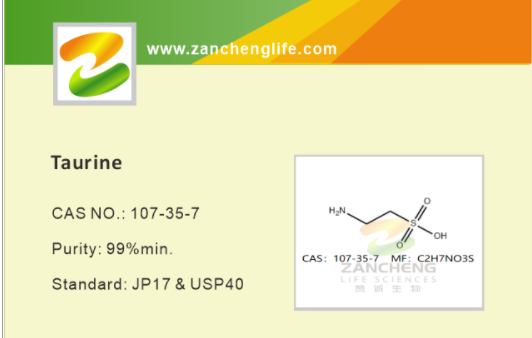Mar. 21, 2022
Taurine, also known as β⁃aminoethanesulfonic acid, taurocholic acid, taurocholine, and taurocholine, is a sulfur-containing amino acid in living organisms with the molecular formula NH2CH2CH2SO3H. Taurine was first extracted from the bile of cattle in 1827, hence the name. Taurine is present in all tissues and organs of animals, accounting for 25% of the free amino acids in the liver, 19% in the brain, 50% in the kidney and 53% in the muscle. In recent years, more and more research has been done on taurine, especially in medicine. Studies have confirmed that taurine has a rich and diverse physiological function, with significant effects in antioxidant, immunomodulatory, and anti-aging cellular activities.
In recent years, many foods have been found to have high levels of taurine. Data from studies have shown that taurine levels measured in the red meat of chicken are ten times higher compared to the white meat of chicken. In contrast, the taurine content in nuts and legumes is relatively low, with less than 0.5 mg per 100 g of nuts or legumes. In addition, taurine is not found in foods such as kelp, Ulva, eggs, peanuts and black rice, and most vegetables. Taurine is most abundant in aquatic animals, while terrestrial plants contain the least amount of taurine. The taurine content of some seafoods can be as high as 0.5%~1% of their fresh weight, and with this value, the taurine content in 1 gram of relevant seafood can be equivalent to 100 grams of infant formula or food.

Taurine has antioxidant effect. Normally, after the food consumed by the body is digested and absorbed, it is converted into energy in the mitochondria and free radicals are produced, which can react directly or indirectly with antioxidants in the body to maintain cellular homeostasis. However, when this balance is disturbed, oxidative stress can occur in the body, leading to inflammation and other diseases. Taurine is an antioxidant that scavenges free radicals, as well as mitigates lipid peroxidation.
In the retina of animal eyes, the content of taurine accounts for about half of the total amino acid content, and as an important factor affecting the development of photoreceptors, taurine is very closely related to the formation of vision. Taurine, as an important factor affecting photoreceptor development, is very closely related to the formation of vision. Taurine deficiency will not only lead to abnormal development or even degeneration of photoreceptors, but will also inhibit many functions of the eye. In addition, taurine supplementation can help improve the night vision of people working in low-light environments.
In the animal body, methionine and cysteine are the initial raw materials for the synthesis of taurine, and after a series of intermediate processes such as decarboxylation of cysteine sulfite decarboxylase (CSAD), intermediate products are formed, and finally taurine is obtained through oxidation. Taurine is an essential amino acid for cats. Taurine is a vital nutrient for cats. If cats lack taurine in their daily diet, it will lead to retinal degeneration or even blindness, and if the level of taurine in their blood drops to a certain level, it will induce myocarditis.

At present, there are three standards for taurine nutritional requirements for cat food published by authoritative international organizations, namely NRC, AAFCO and FEDIAF standards, which clearly specify the amount of taurine required by cats at different growth stages. Among them, AAFCO stipulates that the taurine content of canned food is higher than that of extruded cat food. Because the production process of canned cat food is different from that of ordinary cat food, more taurine is lost during the heating process of canned cat food due to the Maillard reaction, so the amount of taurine added to "canned" cat food is higher than that of "extruded" cat food in the nutrition standard. On the other hand, both "canned" cat food and "extruded" cat food will reduce the utilization of taurine nutrients by cats due to the Maillard reaction. There are two possible mechanisms for the reduction of taurine utilization by cats due to the reaction: first, taurine and other nutrients are converted into brown insoluble substances, which cannot be absorbed and utilized by the gastrointestinal tract; second, after taurine is converted into brown insoluble substances, although it cannot be utilized by the gastrointestinal tract of cats, it can be utilized by microorganisms in the intestinal tract. The intestinal flora is an important factor that affects the utilization and requirement of taurine in cats.
Taurine is an important nutrient for humans, economic animals and pets, and is one of the key factors for the proper functioning of life activities. Lack of taurine intake in the diet will bring a variety of pathological problems to the visual nervous system, nervous system, cardiovascular system, endocrine system and immune system. With the rapid development of the domestic pet industry, it is very important to add the right amount of taurine to cat food to ensure that the ratio of various amino acids in cat food reaches the ideal state, thus increasing the utilization of nutrition in pet cats, reducing the excretion of nutrients and lowering production costs to ensure the normal life function of the animal body.
Contact ZANCHENG to get the quote.
Navigation
Phone:
+86 151 5801 8208
+86 138 0570 9842
E-mail:
Add.:
ROOM 702, NO.318, HUAYUANGANG STREET, GONGSHU DISTRICT, HANGZHOU, ZHEJIANG, CHINA
Request a Quote